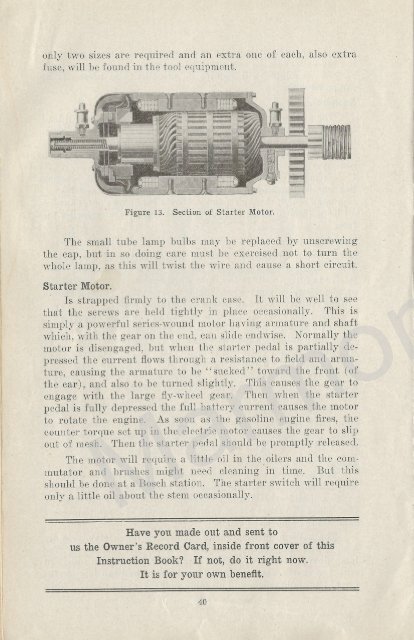1915-07-01 Marmon 41, Info Book, 1534-B wm
Instruction Manual for my 1915 Marmon 41 Club Roadster that my Grandfather bought new 1915. I still drive it today,
Instruction Manual for my 1915 Marmon 41 Club Roadster that my Grandfather bought new 1915. I still drive it today,
You also want an ePaper? Increase the reach of your titles
YUMPU automatically turns print PDFs into web optimized ePapers that Google loves.
only two sizes are required and an extra one of each, also extra<br />
fuse, will be found in the tool equipment.<br />
Figure 13. Section of Starter Motor.<br />
The small tube lamp bulbs may be replaced by unscrewing<br />
the cap, but in so doing care must be exercised not to turn the<br />
whole lamp, as this will twist the wire and cause a short circuit.<br />
Starter Motor.<br />
Is strapped firmly to the crank case. It will be well to see<br />
that the screws are, held tightly in place occasionally. This is<br />
simply a powerful series-wound motor having armature and shaft<br />
which, with the gear on the end, can slide endwise. Normally the<br />
motor is disengaged, but when the starter pedal is partially depressed<br />
the current flows through a resistance to field and armature,<br />
causing the armature to be "sucked" toward the front (of<br />
the car), and also to be turned slightly. This causes the gear to<br />
engage with the large fly-wheel gear. Then when the starter<br />
pedal is fully depressed the full battery current causes the motor<br />
to rotate the engine. As soon as the gasoline engine fires, the<br />
counter torque set up in the electric motor causes the gear to slip<br />
out of mesh. Then the starter pedal should be promptly released.<br />
The motor will require a little oil in the oilers and the commutator.<br />
and brushes might need cleaning in time. But this<br />
should be done at a Bosch station. The starter switch will require<br />
only a little oil about the stein occasionally.<br />
Have you made out and sent to<br />
us the Owner's Record Card, inside front cover of this<br />
Instruction <strong>Book</strong>? If not, do it right now.<br />
It is for your own benefit.<br />
40<br />
Ground Fuse.<br />
If lamps or horn will not operate except when engine is running,<br />
it is a sign that the ground fuse on the right forward side<br />
of dash under the hood has blown out. If you cannot locate any<br />
short circuit, replace the fuse. If this second fuse burns out it is<br />
a sure sign of a short circuit and the condition should be reported<br />
to Bosch or <strong>Marmon</strong> representatives at once. It will not damage<br />
the system to use the lamp and horn while running, but tin' battery<br />
will soon run down, as it cannot be charged, so do not delay<br />
having the matter attended to at once.<br />
Horn.<br />
Should have attention mentioned in special direction book<br />
supplied with each instrument.<br />
UNSCREW<br />
THIS CAP<br />
FILL UP TO<br />
THIS POINT<br />
<strong>Marmon</strong><strong>41</strong>.com<br />
DONT<br />
FILL ABOVE<br />
THIS POINT<br />
Figure 14. Section of Storage Battery.<br />
Arrowhead indicates proper level<br />
of fluid.<br />
Figure 15. Hydrometer Syringe .<br />
or "Chargeometer."<br />
Storage Battery.<br />
On many cars this important member is robbed of its possible<br />
life of usefulness; it is permitted to sicken and die simply through<br />
failure to receive the nourishment essential to its life. The few<br />
necessary precautions are outlined below.<br />
First, battery fluid covering the plates 4 as necessary to your<br />
battery as oil to your motor. "Boiling" and evaporating constantly<br />
lower the fluid level, which must regularly be brought up<br />
to the top of the plates. Never add any fluid except pure distilled<br />
<strong>41</strong>


